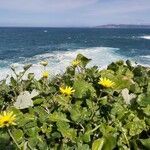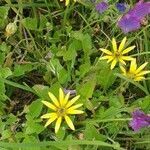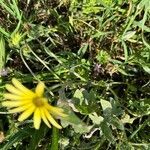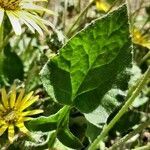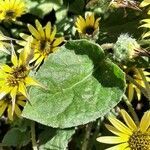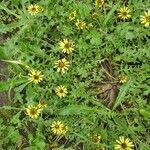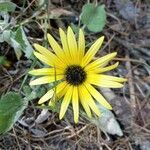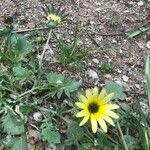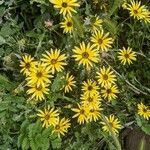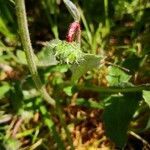Annual rosette herb. Stems sprawling, ascending, up to 30 cm long, rarely 0, with subappressed felty or woolly tomentum and sparse coarse dark multicellular hairs above. Lvs lyrate-pinnatifid to 2-pinnatisect, petiolate, (3)-5-30 × 1-5-(10) cm, with broadly ovate to deltoid terminal lobe and 3-5 pairs of lanceolate, oblong, or oblanceolate lateral lobes, green with scattered short hairs above, silvery with appressed felted tomentum beneath; margins toothed; stem lvs amplexicaul. Capitula solitary on erect scapes. Involucre 1-1.5 cm diam. Involucral bracts in 4-5 series, glabrous or sparsely tomentose, greenish; outermost bracts narrowed into a linear terminal appendage; inner bracts oblong, obtuse, usually scarious or dark on margins. Ligules 1.5-2.5 cm long, pale yellow, tinged greenish or purplish beneath. Disc florets dark. Achenes obovoid, weakly flattened with narrow lateral ridges and a weak dorsal ridge, finely wrinkled, dark brown, 2-2.5 mm long, densely covered with long, buff to mauve woolly hairs. Pappus scales brown or purple, scarious, c. 1 mm long.
Plants usually stoloniferous. Leaves obovate, (2–)5–20(–30+) × (1–)2–5(–7) cm, margins pinnati-sect (lyrate to runcinate), remotely prickly, abaxial faces white-pannose, adaxial faces sparsely puberulent to arachnose, usually glandular as well. Heads 4–7 cm diam. (across the rays). Phyllaries: outer reflexed, apices mucronate, white-woolly; inner appressed, margins hyaline, apices rounded, glabrous. Ray florets 11–17(–25); corolla laminae abaxially greenish to purplish, adaxially yellow (drying to basally ochroleucous, apically blue, forming bull’s eye around disc), 10–25 × 2–4 mm, sparsely puberulent, glandular. Disc florets: corollas yellow proximally, bluish distally. Cypselae dark brown, 3 mm, densely woolly; pappi ca. 0.5 mm (usually hidden by hairs on cypselae).
Perennial herb, often with creeping rooting stems and tufts of radical leaves, or erect and branched, or rosulate. Leaves very variable, lyrate-pinnatifid or rarely sinuate or entire, margins repand and obscurely toothed, glabrous or pubescent above, thinly white-felted below. Peduncles axillary, white-woolly. Capitula solitary; involucre: inner involucral bracts equalling the disc, all scarious with traces of white wool on the backs. Ray florets yellow above, sometimes washed greenish grey below. Disc florets yellow. Pappus of minute, delicate, pointed scales. Flowering time July-Feb. Cypselae enveloped in copious pinkish brown silky wool.
Perennial herb, up to 0.4 m high, creeping, erect or rosulate. Leaves basal or alternate; blade up to 150 x 50 mm, oblong in outline, lyrate-pinnatifid, rarely entire, upper surface glabrous or pubescent, lower surface thinly white-felted; petiole ± 50 mm long. Heads radiate, axillary, solitary, pedunculate. Involucral bracts in many rows, imbricate, inner ones with broad scarious tips. Flowers: ray florets neuter, yellow above, sometimes greenish grey below; disc florets bisexual, yellow; Oct., Apr. Fruits with cypsela small, enveloped in copious pinkish brown, silky wool. Pappus of minute delicate, pointed scales.
Erect, creeping or rosulate annual, up to 200 mm tall, with a tap root or adventitious roots from base, never along stems. Leaves oblong, lyrate-pinnatifid, rarely sinuate or entire, margin slightly sinuate and obscurely toothed, glabrous or pubescent above, thinly white-felted below. Flowerheads radiate, solitary, on a white-woolly peduncle; ray florets yellow above, occasionally greenish grey below, neuter; disc florets bisexual, yellow. Cypselas covered in pinkish brown, silky wool; pappus of minute, delicate, pointed scales.
An annual herb. It has a short stem or no stem. It can grow 30 cm high and 80 cm wide. It has a taproot and ring of leaves at the base. The leaves are 5-25 cm long and 2-6 cm wide. The leaf stalks are 6 cm long. They clasp the stem. The leaves are spear shaped and backward pointing. They have deep lobes and are felted underneath. The flower head is 1.5 cm across and yellow.
Tufted to sprawling, roughly hairy annual to 20 cm. Leaves mostly basal, lyrate to pinnatisect, sometimes bipinnatisect, lobes oblong, toothed, discolorous, woolly below, roughly hairy above. Flower heads radiate, solitary on roughly hairy scapes, black with yellow rays, sometimes with dark bases: outer bracts short, reflexed. Achenes woolly, pappus chaffy.
Perennial herb, creeping, erect or rosulate. Leaves oblong in outline, lyrate-pinnatifid, glabrous or pubescent above, thinly white-felted below. Achenes enveloped in copious pinkish brown silky wool. Pappus of minute delicate pointed scales. Flowers with rays yellow above, sometimes washed greenish grey below, disc yellow.
